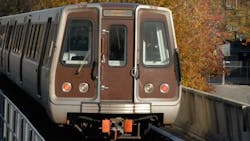WMATA: Regional capital investment has delivered safety, more reliable service
Washington Metropolitan Area Transit Authority (WMATA) reports a safer, more reliable system as it reaches the halfway point of its six-year capital program and marks three years since the National Capital Region agreed to provide the authority with a dependable funding stream to address capital needs.
The “Progress Report to Stakeholders” includes opening statements from WMATA Board of Directors Chair Paul Smedberg and General Manager and CEO Paul Wiedefeld in which Wiedefeld writes “Metro struggled to provide basic levels of service following a prolonged period of underinvestment in the system.”
Following the passage of legislation in 2018 by Maryland, Virginia and the District of Columbia Council to provide WMATA with $500 million in annual funding to aid the transit authority in executing its strategic plan “Keep Metro Safe, Reliable and Affordable,” at the three-year mark, WMATA reports:
- A 50 percent reduction in emergency track repairs since FY2018 through WMATA’s preventative maintenance program;
- A near 80 percent reduction in incidents resulting from insulator fires between FY2018 and FY2021 (from 39 to five);
- The three years of cable meggering work also produced the first fiscal year (FY2021) with zero recorded traction power cable fires;
- All 48 underground stations have received major lighting upgrades, making them up to 10 times brighter while reducing energy consumption by about 60 percent;
- Cellular coverage is available in all tunnels and stations, as well as free Wi-Fi in all 91 stations;
- The Platform Improvement Project has rebuilt 17 of 20 outdoor station platforms scheduled for critical repairs, improving safety and accessibility while adding customer experience improvements such as new passenger information displays;
- Work to increase the system’s water pumping capacity results in 6.75 million gallons of water removed from the system every four days, which is enough to fill the Lincoln Memorial Reflecting Pool; and
- 95 percent of the system’s escalators and 97 percent of its elevators are available for customer use every day on average.
“We are only halfway through the six-year capital program, but the region’s investment is paying dividends to our customers who are getting better service,” said Wiedefeld. “Riders who are returning for the first time since the pandemic will see a more reliable train service than we’ve offered in years.”
Metro’s report notes that customers should expect more work ahead in parts of the system that still need attention, including: new fare gates in rail stations and new fare boxes on buses through the Fare System Modernization program; rehabilitation of the steel-lined tunnel and bridge on the Yellow Line between Pentagon and L’Enfant Plaza stations, starting in 2022; and implementation of projects where pilots are successful, including tunnel waterproofing and tunnel ventilation improvements.
“Our customers can’t always see the investments being made in infrastructure and support systems, but they can notice a difference in the safety and reliability of Metrorail service,” said Smedberg. “While there is more work to be done, the customer experience has improved significantly since the days of SafeTrack.”
The full “Progress Report to Stakeholders – Keep Metro Safe, Reliable and Affordable – 2018-2021” is available through WMATA’s website.
About the Author

Mischa Wanek-Libman
Group Editorial Director
Mischa Wanek-Libman is director of communications with Transdev North America. She has more than 20 years of experience working in the transportation industry covering construction projects, engineering challenges, transit and rail operations and best practices.
Wanek-Libman has held top editorial positions at freight rail and public transportation business-to-business publications including as editor-in-chief and editorial director of Mass Transit from 2018-2024. She has been recognized for editorial excellence through her individual work, as well as for collaborative content.
She is an active member of the American Public Transportation Association's Marketing and Communications Committee and served 14 years as a Board Observer on the National Railroad Construction and Maintenance Association (NRC) Board of Directors.
She is a graduate of Drake University in Des Moines, Iowa, where she earned a Bachelor of Arts degree in Journalism and Mass Communication.
